Living close to nature, finding peace in its natural rhythms and the beauty of trees and wide vistas is a state of mind that has been gaining ground these last few years even in endlessly hectic Taiwan. But few people actually manage to achieve this idyllic state. Chen Wen-hui (
Respectfully called the "kiln master" (
Gardens filled with many plants native to Taiwan are a major part of Huataoyao, and the clay used in the pottery is local Miaoli (
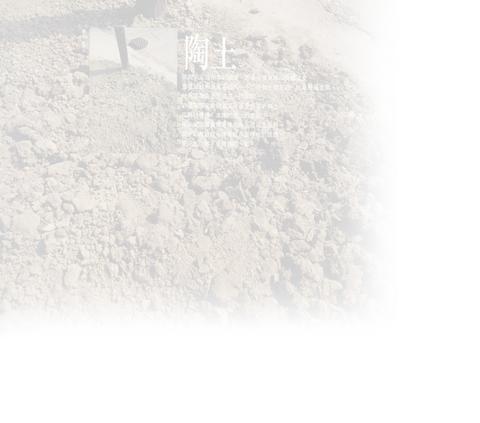
And then of course there is the kiln, the focus of so much of Huataoyao's life.
The main terraced kiln (
The kiln has formed the center of Huataoyao for nearly 18 years. It stands outside the extensive pottery workshop, where high shelves of clay work stand waiting to be fired. Chen Ching-yang (
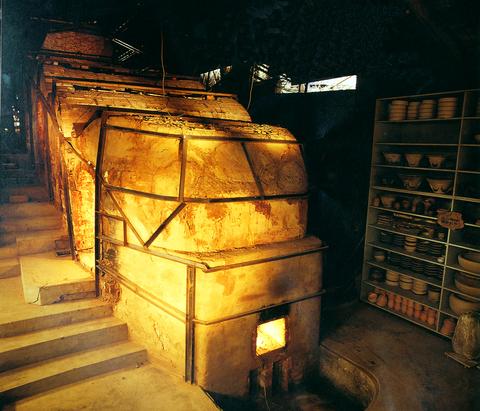
PHOTO COURTESY OF HUATAOYAO
The Huataoyao style, unsurprisingly, is very simple, making use of only one or two glazes and relying on the natural effects of wood ash and the environment of the kiln to produce design elements.
Taking up an aquamarine teapot with a splash of yellow across one side that recalls the liquid ambers which turn the hillside golden in autumn, guide Liu Chen-ru (
"We are still working to create our own style," Chen said, "something that fits the nature concept of Huataoyao, but also something modern."
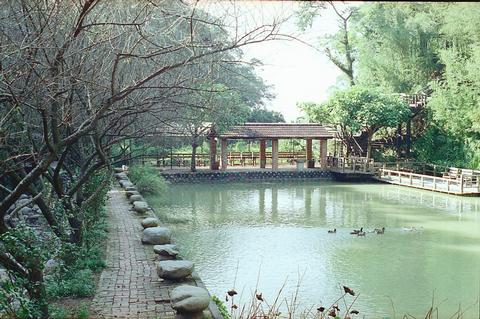
PHOTO: IAN BARTHOLOMEW, TAIPEI TIMES
Huataoyao employs two senior potters who work using traditional designs and methods, while younger potters are experimenting with more geometrical designs. Huataoyao produces a maximum of around 1,000 works each year.
Casting around for new ideas to attract people to Huataoyao, Chen Ching-yang said they were now incorporating various activities such as tea appreciation groups. Liu, who is knowledgeable about the abundant plant life, also hosts these gatherings, where people gather at selected locations in Huataoyao's large gardens. This activity will officially begin on Oct. 31.
Entry to Huataoyao is by pre-arrangement only, a measure that ensures that the surroundings are not overwhelmed by tourists. "It is important that the original inspiration for Huataoyao was not commercial," Chen said.
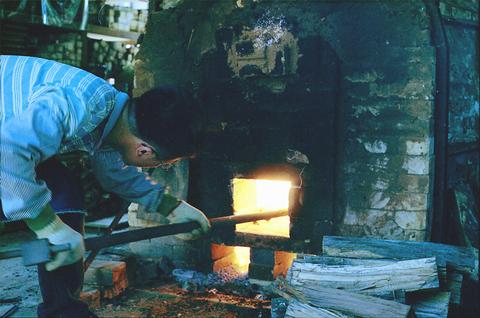
PHOTO: IAN BARTHOLOMEW, TAIPEI TIMES
How well this homely spirit can be preserved in the face of new developments to attract more visitors -- the carefully planned lookout points and tea drinking locations, the pottery displays and pottery classes -- remains to be seen. It has taken the Chen family 18 years to make Huataoyao what it is. The kiln master has never been in a rush. "When we plan a new structure, he puts up a basic framework for a couple of months to see how it fits. If it's good, then work commences. If not, we tear it down and start again," said Chen.
If anything can keep Huataoyao out of the ranks of second-rate tea houses touting dubious spiritual qualities, it is this.
Huataoyao is located at 31, Lin 2, 358 Nanshih Ward, Yuanli township, Miaoli (苗栗縣苑裡鎮358南勢里二鄰31號), tel: (037) 743-611 or on the Web at http://htkiln.com.tw
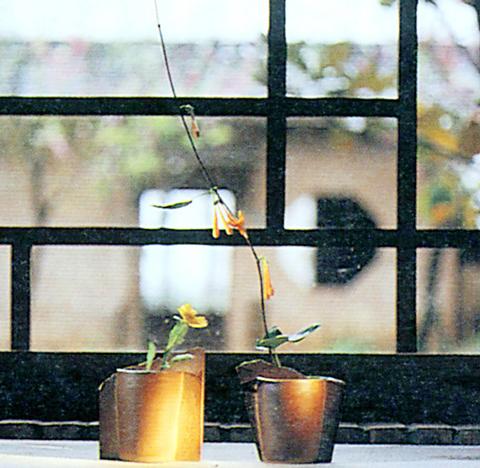
Day tours of the gardens are available for NT$825 on public holidays and NT$675 on other days. A special tea appreciation day will be held on Oct. 31 which will include a specially prepared lunch, special high quality teas and a concert of Taiwanese music for NT$1,200.

This month the government ordered a one-year block of Xiaohongshu (小紅書) or Rednote, a Chinese social media platform with more than 3 million users in Taiwan. The government pointed to widespread fraud activity on the platform, along with cybersecurity failures. Officials said that they had reached out to the company and asked it to change. However, they received no response. The pro-China parties, the Chinese Nationalist Party (KMT) and Taiwan People’s Party (TPP), immediately swung into action, denouncing the ban as an attack on free speech. This “free speech” claim was then echoed by the People’s Republic of China (PRC),

Exceptions to the rule are sometimes revealing. For a brief few years, there was an emerging ideological split between the Democratic Progressive Party (DPP) and Chinese Nationalist Party (KMT) that appeared to be pushing the DPP in a direction that would be considered more liberal, and the KMT more conservative. In the previous column, “The KMT-DPP’s bureaucrat-led developmental state” (Dec. 11, page 12), we examined how Taiwan’s democratic system developed, and how both the two main parties largely accepted a similar consensus on how Taiwan should be run domestically and did not split along the left-right lines more familiar in

Many people in Taiwan first learned about universal basic income (UBI) — the idea that the government should provide regular, no-strings-attached payments to each citizen — in 2019. While seeking the Democratic nomination for the 2020 US presidential election, Andrew Yang, a politician of Taiwanese descent, said that, if elected, he’d institute a UBI of US$1,000 per month to “get the economic boot off of people’s throats, allowing them to lift their heads up, breathe, and get excited for the future.” His campaign petered out, but the concept of UBI hasn’t gone away. Throughout the industrialized world, there are fears that

Most heroes are remembered for the battles they fought. Taiwan’s Black Bat Squadron is remembered for flying into Chinese airspace 838 times between 1953 and 1967, and for the 148 men whose sacrifice bought the intelligence that kept Taiwan secure. Two-thirds of the squadron died carrying out missions most people wouldn’t learn about for another 40 years. The squadron lost 15 aircraft and 148 crew members over those 14 years, making it the deadliest unit in Taiwan’s military history by casualty rate. They flew at night, often at low altitudes, straight into some of the most heavily defended airspace in Asia.